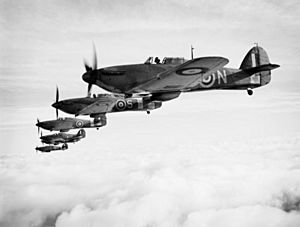Richard John Cork facts for kids
Quick facts for kids
Richard John Cork
|
|
|---|---|
| Nickname(s) | Dickie |
| Born | 4 April 1917 London, England |
| Died | 14 April 1944 (aged 27) China Bay, British Ceylon |
| Buried |
Trincomalee British War Cemetery, Ceylon
|
| Allegiance | United Kingdom |
| Service/ |
Royal Navy |
| Years of service | 1939–1944 |
| Rank | Lieutenant Commander |
| Unit | Fleet Air Arm |
| Commands held | 15th Naval Fighter Wing 880 Naval Air Squadron |
| Battles/wars | Second World War |
| Awards | Distinguished Service Order Distinguished Service Cross |
Richard John Cork (4 April 1917 – 14 April 1944) was a brave pilot known as a fighter ace in the Royal Navy during the Second World War. A fighter ace is a pilot who has shot down five or more enemy aircraft. Cork served in the Battle of Britain as the close flying partner, or wingman, for the famous pilot Douglas Bader.
After returning to the Royal Navy's Fleet Air Arm in 1941, Cork flew with 880 Naval Air Squadron. He served in battles across the Arctic, Mediterranean, and Indian Ocean. During Operation Pedestal in 1942, he achieved something amazing. He became the only Royal Navy pilot to shoot down five enemy planes in a single day! He was also the top naval ace using the Hawker Hurricane aircraft. Later, he was put in charge of the 15th Naval Fighter Wing on the ship HMS Victorious. Sadly, he died in a flying accident over Ceylon (now Sri Lanka) in 1944.
Contents
Richard John Cork was born in London, England, on 4 April 1917. His parents were Harold James Cork and Ethel Mary Cork. They lived in Burnham, Buckinghamshire.
Before the Second World War began, the Royal Navy offered young people who had just finished school a chance to join. They could become officers for a short time. Richard Cork was one of those who signed up in 1939. He passed his interviews and medical tests. On 1 May 1939, he became an acting sub-lieutenant in the air branch. This meant he was training to be a pilot. He started his flying lessons on 21 August 1939. By January 1940, he had earned his flying badge.
World War II Service
In March 1940, Cork was promoted to sub-lieutenant. He flew different types of planes and was rated as an "above average" pilot.
Battle of Britain Hero
During the Battle of Britain, there was a big need for fighter pilots. The Royal Navy asked its pilots to volunteer to help the Royal Air Force (RAF). On 1 July 1940, Richard Cork and two other naval pilots joined No. 242 Squadron. This squadron flew Hawker Hurricane planes and was led by Squadron Leader Douglas Bader. Cork became Bader's wingman, flying right beside him in combat.
On 30 August, Cork had his first fight with the squadron. His unit claimed to have destroyed 12 enemy aircraft. Cork himself was credited with shooting down one Messerschmitt Bf 110 and sharing in the destruction of another. By 13 September, he had shot down five enemy planes. This made him a fighter ace. For his bravery, he was given the Distinguished Service Cross (DSC). This was a special award for naval officers.
Return to the Fleet Air Arm
After the Battle of Britain, Cork went back to the Fleet Air Arm. He joined 880 Naval Air Squadron. This squadron first used Grumman Martlet planes, then switched to Hawker Sea Hurricanes. In mid-1941, the squadron joined the aircraft carrier HMS Furious. They took part in attacks on German targets in Arctic Norway. Cork flew two missions there.
In October 1941, 880 Squadron moved to the new aircraft carrier HMS Indomitable. The next month, Cork was promoted to lieutenant. One of their first missions with Indomitable was an attack on Vichy French positions in Madagascar on 6 May 1942. During these operations, Cork destroyed several enemy planes on the ground.
Operation Pedestal and Command
On 12 August 1942, during Operation Pedestal, Richard Cork made history. He became the only Royal Navy pilot to shoot down five enemy aircraft in one day! For this amazing achievement, he received the Distinguished Service Order (DSO). Flying a Sea Hurricane, he shot down a Savoia-Marchetti SM.79 and a Junkers Ju 88. He also shared in destroying another Junkers Ju 88. Later that day, he shot down a Messerschmitt Bf 110 and another Savoia-Marchetti SM.79.
The squadron's leader was killed during these battles. As the most senior pilot, Cork was given command of 880 Squadron. In September 1942, he was promoted to acting lieutenant commander.
Later Service and Final Days
In November 1943, Cork was assigned to HMS Illustrious. He became the wing leader for the 15th Naval Fighter Wing. This wing had three squadrons of Vought F4U Corsair planes. The carrier sailed to the Indian Ocean to join the British Pacific Fleet.
Sadly, after arriving, Richard Cork was killed in a flying accident. This happened while he was landing at China Bay, Ceylon, on 14 April 1944. He was buried in the Trincomalee War Cemetery. By the end of his service, he had shot down nine enemy planes, shared in two others, and destroyed seven on the ground. He was one of the top five Royal Navy fighter aces of the Second World War.


